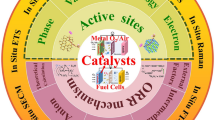Abstract
Selectivity of nanocrystalline anatase electrodes with different preferential surface orientation in formaldehyde reduction was assessed as a model of oxide-based catalyst for electrochemical CO2 valuation. Cathodic behavior of TiO2 (anatase)-based electrodes observed in formaldehyde reaction integrates, in fact, several processes including hydrogen evolution, formaldehyde reduction, and proton insertion into anatase structure. The electrochemical activity of the anatase-based cathodes is, regardless of the surface orientation, dominated by proton insertion. The proton insertion is more pronounced on {001}-oriented anatase than on {101}-oriented nanocrystals due to anisotropy of the proton transport in the anatase which is more facile in the (001) direction. Aside from the proton insertion, both anatase orientations also differ in selectivity in the formaldehyde reduction. While {101} surface orientation produces primarily hydrogen and methanol, the same process on {001}-oriented surfaces shows the ability to produce aside of methanol also hydrocarbons most likely methane. The overall activity towards the reduction of organics is, however, lower than that of metals.

Graphical Abstract










Similar content being viewed by others
References
S. Zinoviev, F. Müller-Langer, P. Das, N. Bertero, P. Fornasiero, M. Kaltschmitt, G. Centi, S. Miertus, Next-generation biofuels: Survey of emerging technologies and sustainability issues. ChemSusChem 3, 1106–1133 (2010)
F. Geppert, D. Liu, M. van Eerten-Jansen, E. Weidner, C. Buisman, A. ter Heijne, Bioelectrochemical power-to-gas: State of the art and future perspectives. Trends Biotechnol. 34(11), 879–894 (2016)
S.C. Roy, O.K. Varghese, M. Paulose, C.A. Grimes, Toward solar fuels: Photocatalytic conversion of carbon dioxide to hydrocarbons. ACS Nano 4(3), 1259–1278 (2010)
Y. Hori, In Modern Aspects of Electrochemistry, Vol 42, Ed. by C. G. Vayenas, R. E. White, M. E. Gamboa-Aldeco (Springer, New York, NY, 2008) p.89
J. Yu, J. Low, W. Xiao, P. Zhou, M. Jaroniec, Enhanced photocatalytic CO2 reduction activity of Anatase TiO2 by coexposed {001} and {101} facets. J. Am. Chem. Soc. 136(25), 8839–8842 (2014)
H. Gerischer, Neglected problems in the pH dependence of the flatband potential of semiconducting oxides and semiconductors covered with OxideLayers. Electrochim. Acta 34, 1005–1009 (1989)
R.M. Torresi, O.R. Cámara, C.P. De Pauli, M.C. Giordano, Hydrogen evolution reaction on anodic titanium oxide films. Electrochim. Acta 32, 1291–1301 (1987)
K.M. Macounová, M. Klusáčková, R. Nebel, M. Zukalová, M. Klementová, I.E. Castelli, M.D. Spo, J. Rossmeisl, L. Kavan, P. Krtil, Synergetic surface sensitivity of photoelectrochemical water oxidation on TiO2 (anatase) electrodes. J. Phys. Chem. C 121, 6024–6032 (2017)
U. Diebold, The surface science of titanium dioxide. Surf. Sci. Rep. 48, 53–229 (2003)
U. Diebold, Structure and properties of TiO2 surfaces: A brief review. Appl. Phys. A Mater. Sci. Process. 76, 681–687 (2003)
L. Kavan, M. Grätzel, S.E. Gilbert, C. Klemenz, H.J. Scheel, Electrochemical and photoelectrochemical investigation of single-crystal anatase. J. Am. Chem. Soc. 118, 6716–6723 (1996)
R. Hengerer, L. Kavan, P. Krtil, M. Grätzel, Orientation dependence of charge-transfer processes on TiO2 (Anatase) single crystals. J. Electrochem. Soc. 147, 1467–1472 (2000)
R. Nebel, K.M. Macounová, H. Tarábková, L. Kavan, P. Krtil, Selectivity of Photoelectrochemical water splitting on TiO2 Anatase single crystals. J. Phys. Chem. C 123, 10857–10867 (2019)
B.O. Burek, D.W. Bahnemann, J.Z. Bloh, Modeling and optimization of the photocatalytic reduction of molecular oxygen to hydrogen peroxide over titanium dioxide. ACS Catal. 9, 25–37 (2019)
D.-N. Pei, L. Gong, A.-Y. Zhang, X. Zhang, J.-J. Chen, Y. Mu, H.-Q. Yu, Defective titanium dioxide single crystals exposed by high-energy {001} facets for efficient oxygen reduction. Nat. Commun. 6, 8696 (2015). https://doi.org/10.1038/ncomms9696
F. Beck, W. Gabriel, Heterogeneous redox catalysis on Ti/TiO2 cathodes—Reduction of nitrobenzene. Angew. Chemie Int. Ed. English 24, 771–772 (1985)
A. Bagger, W. Ju, A.S. Varela, P. Strasser, J. Rossmeisl, J. Electrochemical, CO2 reduction: A classification problem. ChemPhysChem 18(3266–3273) (2017)
P.G. Russell, N. Kovac, S. Srinivasan, M. Steinberg, The electrochemical reduction of carbon dioxide, formic acid, and formaldehyde. J. Electrochem. Soc. 124, 1329–1338 (1977)
D. Barnes, P. Zuman, Polarographic reduction of aldehydes and ketones: XV. Hydration and Acid-base Equilibria Accompanying Reduction of Aliphatic Adehydes. J. Electroanal. Chem. Interfacial Electrochem. 46, 323–342 (1973)
A. Javier, B. Chmielowiec, J. Sanabria-Chinchilla, Y.G. Kim, J.H. Baricuatro, M.P. Soriaga, A DEMS study of the reduction of CO2, CO, and HCHO pre-adsorbed on cu electrodes: Empirical inferences on the CO2RR mechanism. Electrocatalysis 6, 127–131 (2015)
H. Liu, X. Wang, C. Pan, K.M. Liew, First-principles study of formaldehyde adsorption on TiO2 rutile (110) and anatase (001) surfaces. J. Phys. Chem. C 116, 8044–8053 (2012)
M. Kobayashi, K. Tomita, V. Petrykin, M. Yoshimura, M. Kakihana, Direct synthesis of Brookite-type titanium oxide by hydrothermal method using water-soluble titanium complexes. J. Mater. Sci. 43, 2158–2162 (2008)
M. Kobayashi, H. Kato, M. Kakihana, Synthesis of titanium dioxide nanocrystals with controlled crystal- and micro-structures from titanium complexes. Nanomater. Nanotechnol. 3, 23 (2013)
A. Ghicov, H. Tsuchiya, R. Hahn, J.M. Macak, A.G. Muñoz, P. Schmuki, TiO2 nanotubes: H+ insertion and strong electrochromic effects. Electrochem. Commun. 8, 528–532 (2006)
M.V. Koudriachova, S.W. de Leeuw, N.M. Harrison, Orthorhombic distortion on li intercalation in Anatase. Phys. Rev. B 69, 054106 (2004)
S. Lunell, A. Stashans, L. Ojamäe, H. Lindström, A. Hagfeldt, Li and Na diffusion in TiO2 from quantum chemical theory versus electrochemical experiment. J. Am. Chem. Soc. 119, 7374–7380 (1997)
Y.Y. Birdja, M.T.M. Koper, The importance of Cannizzaro-type reactions during electrocatalytic reduction of carbon dioxide. J. Am. Chem. Soc. 139(5), 2030–2034 (2017)
R.C. Millikan, K.S. Pitzer, Infrared spectra and vibrational assignment of monomeric formic acid. J. Chem. Phys. 27, 1305–1308 (1957)
Funding
VB would like to acknowledge for the financial support of the European Commission within the framework of the Innovative Training Network Elcorel (Contract 722614).
Author information
Authors and Affiliations
Corresponding author
Additional information
Publisher’s Note
Springer Nature remains neutral with regard to jurisdictional claims in published maps and institutional affiliations.
Rights and permissions
About this article
Cite this article
Buravets, V., Minhová Macounová, K., Nebel, R. et al. Surface Sensitivity of Hydrogen Evolution and Formaldehyde Reduction on Differently Oriented TiO2 Anatase Nanocrystals. Electrocatalysis 12, 15–25 (2021). https://doi.org/10.1007/s12678-020-00595-x
Published:
Issue Date:
DOI: https://doi.org/10.1007/s12678-020-00595-x




